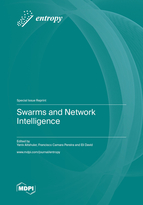Swarms and Network Intelligence
A special issue of Entropy (ISSN 1099-4300). This special issue belongs to the section "Information Theory, Probability and Statistics".
Deadline for manuscript submissions: closed (1 September 2022) | Viewed by 28798
Special Issue Editors
Interests: federated learning; machine learning; network theory; social physics; swarm robotics
Interests: intelligent transportation systems; machine learning and pattern recognition; transport modeling; computational creativity
Special Issue Information
Dear Colleagues,
The last decade has seen a transformative change in the paradigms, tools and processes utilized for the analysis, modeling and design of data-driven systems. A macrolevel-oriented design is gradually being replaced by bottom–up design methodologies, that emphasize micro-level interactions and efficient composability for the emergence of an optimal macroscopic result. Spanning from rapid penetration of autonomous vehicles and decentralized intelligent ride-sharing systems, through the increasing dominance of autonomous trading machines in the equities, currencies and commodities markets, to the growing appetite of decentralized autonomous scalable big-data dependent mechanisms in the intelligence and defense spaces.
This Special Issue aims to be a forum for the presentation of new and improved techniques for the modeling and analysis of swarm architectures and network-driven system designs. In particular, the analysis and interpretation of such approaches in real-world natural and engineered environments falls within the scope of this Special Issue.
We particularly welcome original research works that focus on information-driven theoretic analysis or modeling approach.
- Information diffusion in real-world networks: temporal influence analysis and mutual information dynamics among nodes in real-life
- Collective and swarm intelligence: decentralized information processing and decision making
- Urban computing and smart cities: theoretical aspects of large-scale dynamic metropolitan multi-layered networks
- Autonomous collaborative security: self-organization and resilient information processing
- Intelligence transportation systems: information flow in geographically-embedded networks
- Smart contracts and cryptocurrencies: computation limitation, convergence and information leakage
- Decentralized finance (DeFi): effects of composability of information processing units on the future of economy
Dr. Yaniv Altshuler
Prof. Francisco Camara Pereira
Dr. Eli David
Guest Editor
Manuscript Submission Information
Manuscripts should be submitted online at www.mdpi.com by registering and logging in to this website. Once you are registered, click here to go to the submission form. Manuscripts can be submitted until the deadline. All submissions that pass pre-check are peer-reviewed. Accepted papers will be published continuously in the journal (as soon as accepted) and will be listed together on the special issue website. Research articles, review articles as well as short communications are invited. For planned papers, a title and short abstract (about 100 words) can be sent to the Editorial Office for announcement on this website.
Submitted manuscripts should not have been published previously, nor be under consideration for publication elsewhere (except conference proceedings papers). All manuscripts are thoroughly refereed through a single-blind peer-review process. A guide for authors and other relevant information for submission of manuscripts is available on the Instructions for Authors page. Entropy is an international peer-reviewed open access monthly journal published by MDPI.
Please visit the Instructions for Authors page before submitting a manuscript. The Article Processing Charge (APC) for publication in this open access journal is 2600 CHF (Swiss Francs). Submitted papers should be well formatted and use good English. Authors may use MDPI's English editing service prior to publication or during author revisions.







